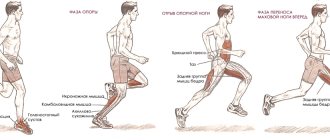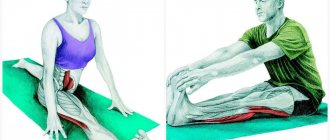Poster for the film “Red Start”.
Alexey Republicommando translated for Zozhnik a huge, fresh review of scientific literature (51 works, list attached) on the benefits and harms of aerobic training volume.
Almost everyone knows that physical activity is beneficial. A wealth of scientific evidence supports the therapeutic effects of exercise on quality of life, cardiovascular health, and longevity.
Why is it dangerous to run too much?
However, many people mistakenly believe that the more, the better. Excessive cardio training volume can have a negative impact on cardiovascular health. Ultramarathon running may result in myocardial damage , as evidenced by elevated levels of troponin and brain natriuretic peptide.
Additionally, sudden cardiac arrest occurs more frequently in marathons and triathlons than in shorter distance events. Older marathon runners often exhibit abnormal cardiac remodeling (structural changes) with an increased risk of myocardial fibrosis and ischemic calcification.
Chronic excessive exercise is associated with an increased risk of atrial fibrillation (AF).
Caricature “Running from a Heart Attack”, Ruslan Dolzhenets.
Three criteria for healthy running
Evgeny Kadlubinsky also recommends taking into account three main criteria by which you can determine your body’s readiness for running.
If you can speak calmly while running without shortness of breath, then most likely you have chosen a safe pace for yourself. You are running in heart rate zone 1 or 2. And these are safe areas for long-term work.
If you are running and your breathing is even, you can breathe through your nose - this is another signal that your pace is safe for your health.
This also means that you have received the optimal running load. If these three criteria are met and you feel good, then your running pace is relatively correct.
If you have already successfully run for a long time, this does not mean that you do not need to control your body. It is very dangerous to overtrain here, and then running will not benefit your health.
How much running is good and how much is harmful?
The optimal dose of cardio is likely to vary between individuals and is not well established at this time. So far, current research indicates that 2.5 to 5 hours of moderate to vigorous physical activity per week will provide the greatest benefit ;
But >10 hours/week may already reduce these health benefits .
Conversely, a sedentary lifestyle and excess weight, in addition to being causes of premature death and disability, have many adverse consequences, especially for the cardiovascular system (CVS). About half of the adult population in the United States today suffers from some form of CVD [1].
Physical exercise is one of the powerful tools for the prevention of cardiovascular diseases [2], and together with the improvement of the cardiovascular system, the development and severity of coronary heart disease (CHD) is prevented and the risk of other diseases is reduced .
There is such an indicator - MET - “metabolic equivalent of physical activity” (here, for example, you can read more about it). Each additional MET unit reduces all-cause mortality by 30% in untrained individuals (who initially have <5 METs of exercise) [3].
And here’s another serious figure: physically active middle-aged people will live on average 8 years longer than “sedentary” people ; and for patients with diagnosed CVD, cardiac rehabilitation improves prognosis and quality of life [4].
Exercise has a positive effect on almost every aspect of the body and brain, improving physical and mental well-being; staying physically active is one of the best ways to maintain health and increase your life expectancy.
Although the ideal dose of exercise has not yet been determined, it is clear that at least half of Americans do not get the recommended 150 minutes of moderate physical activity per week.
Even light-to-moderate-intensity physical activity for as little as 15 minutes per day , about half the recommended minimum dose, has significant longevity benefits, with the most dramatic risk reductions seen when moving from a completely sedentary to a lightly active lifestyle [7 ]. On the other hand, about 2.5% of American adults over-exercise, thereby exposing themselves to potential detrimental health effects [7].
The topic of the optimal dose of physical activity to ensure the best health and longest life expectancy is actively discussed in the scientific literature. The purpose of this article is to clarify this issue by focusing on the body of accumulated evidence [8-14].
Training program
If you are interested in how much you need to run to lose 1 kg or 10-15 kg, we will advise you to choose a program and then carefully follow its steps. Such schemes take into account both energy costs and duration of training, and also divide the entire schedule into the required number of days (months), so they are convenient.
Here are some popular programs:
If you are not pursuing the goal of losing weight, and you are interested in how much you need to run a day for health, end the workout when you feel that it has ceased to be enjoyable. Always go out on the track in a good mood and never force yourself to do exercises.
Cardio effect curve
The optimal dose of physical activity that brings maximum health benefits is still unknown to us [15]. Even 2,500 years ago, Hippocrates taught: “If we could give every person the right amount of food and exercise—not too little and not too much—we would have found the safest path to health.”[7] Even then, scientists understood that a certain range would be optimal for improving well-being and life expectancy; a smaller or larger training volume would reduce the benefits.
Paffenbarger described the relationship between physical activity (walking, climbing stairs, and playing sports) and all-cause mortality using the reflected J curve as early as 1986. The study followed 16,936 Harvard graduates for 16 years and found that moderate exercise reduced risk the most [16].
Since then, numerous large observational studies, collectively covering more than 3 million people, have shown similar results, suggesting that there appears to be an upper threshold at which very high doses of intense exercise appear to be associated with loss. some longevity benefits associated with less extreme doses of intense exercise.
As shown in the graph below, almost all large observations reproduce this reflected J-curve. It shows how the risks of CVD and premature mortality are reduced in a dose-dependent manner until an activity threshold is exceeded, after which the benefits decline. In many studies, this risk reduction is not statistically significant due to the small number of individuals in the “extreme” cohort, yet this association has been repeatedly found; In the largest studies, the reduction in health benefits observed with extremely high doses of exercise remains statistically significant [8].
Each curve is one study. Vertical - risk level, yellow dot - no physical activity, green - optimal level of activity, red - maximum activity.
Alternatives to running for weight loss
In conclusion, here are a few exercises that are considered an excellent alternative to running, and are great for helping you lose weight or temporarily replace jogging:
- Stepping up to an elevated position. The height of the object you are stepping on should not be higher than the middle of your shin. This exercise is easy to perform at home and it is almost in no way inferior to the running load, especially if you do it at a fast pace;
- High jumps (we recommend studying different variations of this exercise, they are all equally useful);
- Jumping rope - the more intense and often you jump, the more effective the training will be.
If you decide to run on a treadmill to lose 10 kg or more, you can successfully use any of the programs given in the article, because a treadmill perfectly replaces a natural track. The disadvantage of this activity is its monotony and less fresh air.
We hope you understand that the main idea that we tried to convey to you, explaining how much you need to run to lose weight, is that it is not the duration of the activity that is important, but its quality. The more effort you expend, the more and faster you will lose weight and nothing else!
Arrhythmia: Increases approximately 5-fold in veteran runners
Physical exercise is associated with positive adaptations of CVD, including dilation of all heart chambers, improved function, increased compliance of the cardiac and vascular wall, sinus bradycardia, etc. [17, 18].
However, there is a well-documented increase in the incidence of atrial fibrillation (AF) in endurance athletes. A study of 300 veteran runners (mean age 47.5 years) found a 5-fold increase in the incidence of MA compared with a sedentary control group [19]. Since then, studies have linked MA to more intense training protocols, faster finishing times, and the absolute number of races completed [20].
Long-term endurance training (≥2000 hours and/or ≥20 years of training) is strongly correlated with MA, even in individuals without CVD risk factors [21, 22].
Although individual studies have concluded that the risk of MA may increase by 2- to 10-fold, a recent meta-analysis quantified the risk to be approximately 5-fold [23].
As with many other things, moderate amounts of physical activity prevent MA, while both low and high volumes are associated with an increased risk of developing MA .
Inactive people (<6 METs) have an increased rate of developing MA (compared to more athletic people), and each additional 1 MET is associated with a 7% reduction in the risk of developing MA [24].
In terms of weekly dose of physical activity, even small amounts starting at 5 MET-hours/week appear to reduce the risk of developing MA, with maximum benefit observed at 20 MET-hours/week (see graph below) [25] .
Above 55 MET-hours/week, which is approximately 10 hours of intense physical activity per week, the likelihood of developing MA begins to exceed the risks of the sedentary cohort [25].
Vertical – relative risk of MA, horizontal – volume of physical activity (MET-hour/week), green zone – risk reduction, yellow – approximately equal risks, red – increased risk.
Diagnostics is everything
Why is it important to conduct a diagnosis before starting running? Because we must identify our weakest point. According to the law of the weakest link in the chain, the maximum strength of the chain is equal to the maximum strength of the weakest link. The same can be said about the capabilities of our body. Our running intensity, which will be harmless to health, should be at the level of our weakest link in the body.
The weak link can be both in the musculoskeletal system and in the cardiovascular system. And, based on the diagnostic data, we build the running intensity. By the way, with the help of a properly selected running load, you can not only maintain your health, but also strengthen your weak links.
If it is not possible to contact a professional sports doctor and use special equipment for diagnosis, it will be enough to visit a therapist before starting classes and undergo a medical examination, which includes detailed blood tests and a visit to a cardiologist.
Myocardial fibrosis
Myocardial fibrosis is a nonspecific reaction to various cardiac injuries, such as acute myocardial infarction, myocarditis, uncontrolled hypertension and valvular dysfunction. Pathological fibrosis of the heart predisposes to myocardial stiffness, arrhythmia and other adverse consequences [31]. Myocardial fibrosis is best detected by cardiac magnetic resonance imaging (MRI), especially in cases of late gadolinium accumulation (LGA) .
Chronic endurance training overload increases the risk of developing PNH , which has been found in healthy, asymptomatic endurance athletes [31–33]. In addition, PNH is significantly and directly correlated with training experience (in years) and the number of marathons and other ultra-endurance events completed [32, 34].
During strenuous exercise, cardiac output increases approximately 5 times compared to resting values (from 5 L/min to 25 L/min or more), which leads to a disproportionately distributed load on the heart with an increase in the load on the walls by 125% compared to with 4% on the right and left ventricles [35].
Such stress, coupled with a sustained increase in catecholamines and reactive oxygen species, likely causes cumulative injury in the myocardium, ultimately leading to scarring as demonstrated by PNH.
The presence of PNH can be detected by analyzing the number of ultramarathons in which the athlete has taken part, or the severity of coronary artery calcification [34].
Cumulative cardiac MRI data show that PNH occurs in 12% of endurance athletes, which is 8 times higher than the 1.5% rate observed in controls with the minimum dose of physical activity recommended by the WHO (see graph below) [15 ].
Blue column - age endurance athletes, red - total age athletes, orange - sedentary control group, purple - total sedentary control participants. Adapted from Franklin et al. [15]
Celebration or struggle?
If you have found out that running is not contraindicated for you, and now you want running to be beneficial, you need to decide on the strategy for your runs: running as a holiday or running as a struggle.
Depending on your attitude and training simulation, your body will produce different hormones that will affect your health differently.
A sports culture is now actively being formed in Russia. Everyone wants to run harder and faster, attend every race in the area and endlessly update their personal best. If you constantly go out to train in such an intense mode, running ceases to be beneficial to health. Instead of the desired endorphin, we will tire our body more and more, producing cortisol (stress hormone). And then sport, instead of a holiday, will become sheer stress and struggle for us. This model of the training process is traumatic and demotivating.
When choosing one running strategy or another, it is important to remember proper recovery. Never try on the training of experienced athletes!
Professional athletes train, rest, eat and then train again. And amateurs train, wanting to run a half marathon in 1 hour 30 minutes or a “ten” marathon in 35 minutes, while still going to work and doing household chores, which means they cannot receive full recovery a priori. Thus, they drive their body into terrible conditions of chronic fatigue.
A positive running model is about proper recovery.
For running to be beneficial, stress must be measured. High-quality recovery is mandatory: sleep at least 8 hours.
Coronary artery calcification
A large body of evidence shows that the amount of calcium in the coronary arteries is an accurate predictor of CVD risk [37]. Paradoxically, although exercise reduces the risk of CAD, too much endurance training appears to significantly increase calcification , bringing us back to the reflected J-curve graph (Figure 4) [38].
Athletes aged 54±8 years have approximately 2 times more atherosclerotic plaques than the control group; these athletes also have a higher degree of calcification [39].
On the vertical line – the degree of calcification of the coronary arteries, on the horizontal – age in years (y) and the number of participants (n).
Association of physical fitness level with the degree of coronary artery calcification. CAC = coronary artery calcification; FAC = functional aerobic capacity. Adapted from Kermott et al. [38]
Overall, studies have confirmed that older endurance athletes have higher rates of coronary calcification than sedentary controls, but they tend to have fewer harmful plaques of mixed calcification and lipid origin [39–41]. Despite this, highly active individuals showed a non-significant trend toward reduced mortality compared with the less active cohort [40].
Acute risks associated with intense exercise
Up to 90% of all sudden cardiac deaths (SCD) associated with exercise occur in recreational rather than competitive athletes , with the incidence of such deaths ranging from 1:22,000 to 1:69,000 in adults, compared with 1:50,000 in youth athletes participating in competitions [43, 44]. The risk of SCD is highest during and immediately after exercise [15]. One study found that the risk of SCD increased short-term by 17-fold during and for 30 minutes after the end of intense exercise.
This risk is much higher in less active people compared to those who exercised more often (relative risk 74 versus 11) [15]. Another study also found that the sedentary cohort had a 25 times higher risk of SCD than those who exercised at least a little [15].
In athletes over 35 years of age, more than 80% of SCD were caused by coronary artery disease (CHD); while among younger athletes (<35 years), the most common causes of SCD were congenital anomalies of the heart muscle, coronary vessels and conduction system [45].
Longer, more physically demanding runs appear to increase the risk of SCD. Data from nearly 11 million long-distance race participants show a higher prevalence of SCD in marathons (1.01/100,000) compared with half marathons (0.27/100,000). Only 29% of victims were able to survive cardiac arrest [46].
It is worth noting that the mortality rate for men was more than 2 times higher than the mortality rate for women (0.98 versus 0.41/100,000) [47].
Triathletes have been reported to have higher rates of SCD than marathon runners. In an analysis of data from 4.7 million triathletes, the incidence of SCD was 1.74/100,000 [48].
As in marathons, the risk for men is 3 times higher than for women (2.40 vs. 0.74/100,000).
Additionally, the risks were 3 times higher for men over 40 years of age compared to younger participants [48].
Acute myocardial infarction (MI) is also more common during or shortly after intense exercise. A number of studies have found that the risk of MI increases 2-10 times within an hour after exercise [15].
Endurance exercise, including marathons and ultramarathons, influences a number of biomarkers of cardiovascular disease. A study of 40 athletes (marathon, triathlon, mountain biking) found that right ventricular ejection fraction decreased by 9% after the race. Regular exposure of the right ventricle to strenuous exercise can cause myocardial necrosis, which ultimately leads to scarring and irreversible remodeling, setting the stage for arrhythmias. The estimated amount of physical activity leading to this effect is thought to be >20 hours per week for >20 years [43].
Cross training
One study of elite runners found that they were able to improve their three-kilometer performance by replacing 30% of their running training with plyometric training.
“I know many professional runners who successfully train 14 times a week and do not cross-train,” Fitzgerald says. – However, for those who run more than 9 times a week, I advise reducing the number of running sessions to 7 and adding 2-3 weight training sessions or plyometric exercises. It will be more beneficial than just running every day.”
To summarize all of the above. The number of training sessions depends on many different factors, but for successful progression, try to do at least three running workouts per week. Although it is important to remember that quantity does not always develop into quality.
Based on materials from running.competitor.com











